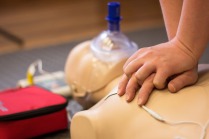Fetal Positions: Find Out Which Your Baby Is In
There are 4 different positions that your baby might currently be in…
26 September 2018
Lara

During the course of your pregnancy, your baby will move into several different positions especially as your labour nears.
You’ve probably experienced the feeling of your baby moving inside your womb and this is nothing new to you.
But as your baby develops more and more throughout the duration of your pregnancy, they will reach different positions.
SEE ALSO: Try this easy method to calculate your week of pregnancy and due date
While some positions are safe – others, when labour approaches, are not so safe. This is important because the fetus must reach an ideal position for a safe delivery.
No need to panic, instead try to familiarise yourself with the following fetal positions during your pregnancy.
1. Anterior position
Otherwise known as the vertex, cephalic or occiput anterior position - this position is considered to be the best and safest position for the fetus to be in before you give birth.
Majority of fetuses reach this position during the last month of pregnancy – it’s when the head of the fetus is pointed towards the ground and is facing your back.
The anterior position helps reduce the chances of complications during your childbirth – by reaching this position the baby’s head can be tucked in and press down on the cervix.
This eventually pushes the cervix to open during labour for an easy delivery.
2. Posterior position
Otherwise known as back-to-back position – this is when the head of the baby is pointing down but their back is facing against your own back.
Posterior positions sometimes make it difficult for the baby to tuck their heads inwards and push through the cervix – which can make their passing through the pelvis harder.
A good thing to consider is: you are more prone to posterior positions if you spend long periods of time sitting and laying down during your pregnancy.
3. Transverse lie position
Remember this as the horizontal position because it means just that – your baby is lying in a horizontal position in your womb.
This is usually not the case for the weeks leading up to the childbirth, but exceptions like this do happen when pregnant.
And when it does, the delivery of the baby would be done via a cesarean method.
This is because without the cesarean delivery, the baby is at risk of wrapping itself in the umbilical cord cutting off blood and air supply.
4. Breech position
This position refers to when your baby is still positioned upwards – the fetus’ head remains up instead of down towards the woman’s pelvis.
There are also three types of breech positions that your baby can be in:
- Frank breech: This is when the baby’s legs lie upwards infront of their body - feet near the face.
- Complete breech: This is when the fetus is in a sitting position – legs crossed infront of their body.
- Footling breech: This is when the baby has one foot above them and one underneath them – sometimes both up or both down.
What’s the best fetal position?
The anterior is the safest but all the others are somewhat safe as well, except for the breech that can cause complications.
Usually at around week 36 of your pregnancy, your doctor will ensure that your baby is in the anterior or posterior position for a safe delivery.
To find out which position your baby is in, you can speak to your doctor, doula or midwife.

























.png?itok=SvZPqMHH)




.png?itok=uB2ieOR7)












